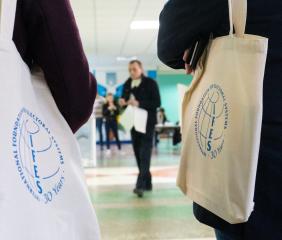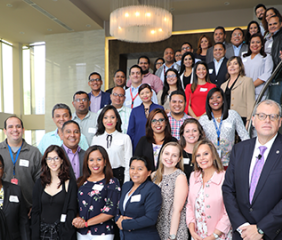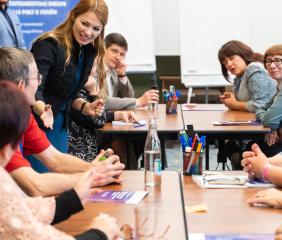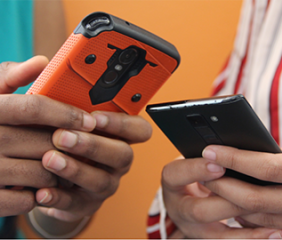Tools & Resources
Filter by
Type
Publication date
Language
Type
Publication date
Language
News & Updates
Feature
From Ballots to Touch Screens: Integrating Technology into Voting
Digital ballot readers, electronic results transmission systems and SMS messaging to inform the electorate can help countries streamline and improve the electoral process. As election management bodies turn to technology to help run elections, they must take their country's cultural, political and legal context into consideration to ensure the new systems enhance — and don't disrupt — democracy. This gallery shows some of the technological tools that are being used around the world.
News & Updates
Feature
The Philippines Goes to the Polls
On May 10, 2010 Filipinos went to the polls to cast ballots for president, vice-president, senators, congressmen, governors, mayors and other key offices in their national and local election. For the first time ever, Precinct Count Optical Scan (PCOS) machines were used nation-wide. These images, taken by John Lawrence, IFES congressional affairs manager, provide a glimpse into the preparations for Election Day and the polling day itself in the Manila metropolitan area.
News & Updates
Interview/Speech/Testimony
Electoral Complaints Adjudication in the Philippines
Transcript of Podcast with Minnesota Supreme Court Justice Paul Anderson and election lawyer and recount expert John “Jack” Harding Young discussing their experience working in the Philippines with IFES and the American Bar Association on the area of Electoral Complaints Adjudication in the Philippines.
News & Updates
Feature
The Philippines Registers for Local Elections
Following the presidential and legislative elections held in May, the Philippines will hold local elections on October 25, 2010. In these elections, Filipinos will vote for Barangay (village) and SK (youth council) representatives. Registration for these elections took place in August throughout the country. During the registration process, the registrants’ digital photo, thumbprints and digital signature are taken by the data-capturing machines or “DCMs”. The thumbprints are later used to conduct an automated fingerprint identification system (AFIS) to find matches or “duplicate registrants” in order to avoid having voters cast more than two ballots on Election Day. These images capture the registration process in the Manila metropolitan area.
Publication
Report/Paper
Application of Election Technology: Considerations for Election Administrators, Practitioners and Policy Makers
When election administration practitioners and policy makers examine the practical
interests of improving election processes and administrative procedures, invariably the
issue of technological enhancements must be considered. The introduction of various
technological systems has been widely adopted by most election bodies throughout the
world. Indeed election processes have benefited greatly from the widespread adoption of
technological platforms to enhance election administration in areas such as voter registry
management, electoral district demarcation, results and tabulation transmission and
reporting and electronic voting systems.
May 10, 2009
Publication
Report/Paper
Best Practices and Pitfalls in the Procurement of New Technologies for Elections
Administration of elections is a complex business. Most senior administrators, whether
they are elected officials, politically appointed or employed as civil servants, come
from other fields with little or no specific election experience. Many are lawyers or
judges; others are employees of government offices responsible for civil registries, tax
records, or vital statistics. Still others are politically prominent citizens nominated by
political parties to serve on election commissions activated during election cycles.
Most of them become “election professionals” through actual experience on the job.
As all election officials learn, the picture is never static.
November 19, 2008
Publication
Report/Paper
Briefing Paper on Republic Act No. 9369 and the Automated Election System
On January 23, 2007, less than four months
before the May 14, 2007 congressional and
local elections, President Gloria MacapagalArroyo
signed into law Republic Act (RA) No.
9369. This law amended and repealed almost
all of RA 8436', a 1997 law that authorized
the conduct of an automated election.
Questions were raised as to whether the May
2007 elections would be automated. But the
Commission on Elections (COM ELEC)
declared that it was not possible to conduct
an automated election as there was not
enough time to prepare for it.
March 31, 2008
Publication
Report/Paper
From Power Outages to Paper Trails: Experiences in Incorporating Technology into the Election Process
This white paper is authored by four election technology experts who offer insights and recommendations about the best ways to introduce and manage new election technologies. The implementation of new election technologies--and the issues it raises--are examined in three chapters, with an introduction by IFES: · Maximizing the Potential for Successful Election Technology Projects (Mike Yard and Ronan McDermott) · The Introduction of New Technologies from the Election Administrator’s Perspective (Linda Edgeworth) · Perspectives on Electronic Voting (Dr. Douglas Jones, U. of Iowa)
March 26, 2007
Election Material
Civic Education Material
Boletin de Automizacion
“Bulletin of Automation” is an informative bulletin, available in Spanish, issued in 1998 in Venezuela in an effort to familiarize voters with the benefits of having an automated voting system. The document covers the information on the automation of voting system in Venezuela.
Publication
Report/Paper
Philippines: House of Representatives Modernization: A Technical Assessment
This report assesses the technical needs of the Philippine House of Representatives (HOR) for its modernization project (circa 1997). IFES objectives were to analyze information technology needs of the HOR, analyze the existing resources available to the House, and provide recommendations for updating the computerized capability.
September 30, 1997



